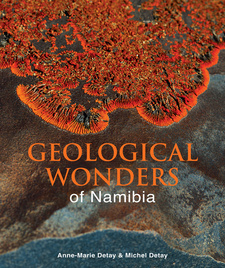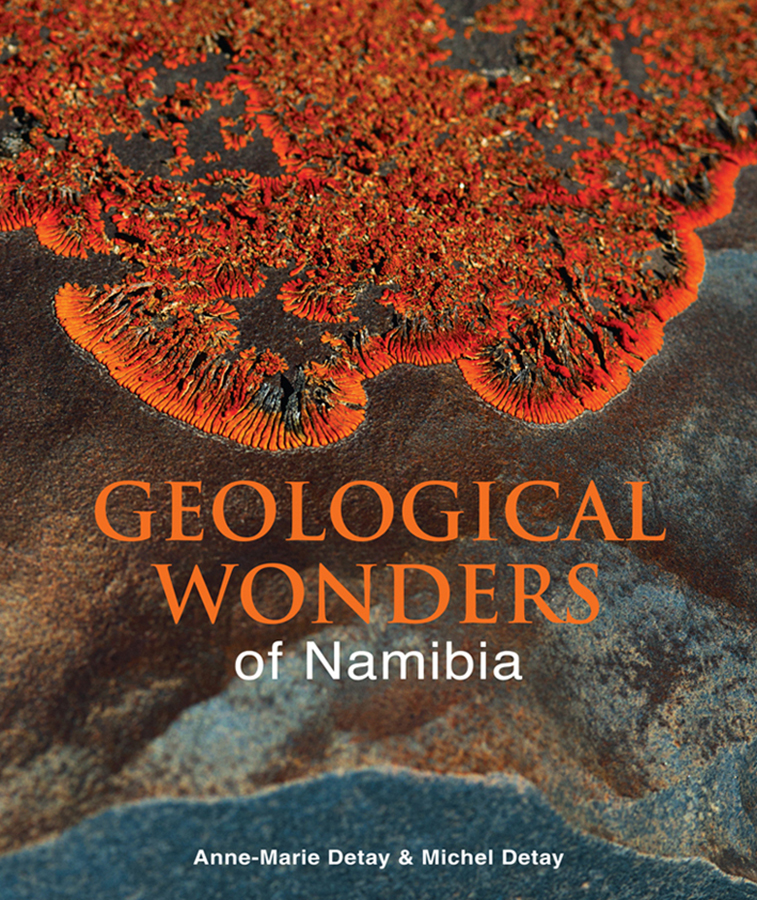Geological Wonders of Namibia, by Anne-Marie Detay and Michel Detay

Geological Wonders of Namibia, by Anne-Marie Detay and Michel Detay. Penguin Random House South Africa, Nature. Cape Town, South Africa 2017. ISBN 9781775842941 / 978-1-77584-294-1
Anne-Marie Detay and Michel Detay have documented their travels and the geological wonders of many regions, including those of Namibia.
Introduction to Geological Wonders of Namibia
[...] A third wave of mountain buildings known as the Damara Orogen, took place when the Congo and Kalahari cratons collided. The area between the two cratons had been a shallow sea, the Khomas Ocean, and the collision of the cratons resulted in the formation of Alpine or Andes-type mountain belts called the Damara Mountain range. Central Namibia was an active volcanic zone, and intrusions accompanied the mountain-building process between 650 and 460 Ma. More than 200 extensively mineralized granitic plutons intruded the Damara Sequence during this period. The Otavi region in northern Namibia is composed of some 5,000 km² of limestone terrains and numerous stromatolites. Karstic weathering in this region led to the development of caves, cenotes (Chapter 5) and huge underground lakes. As the tectonic plates drifted across the Earth's surface, Namibia came to be located at the South Pole, and was covered by a huge ice sheet, before plate tectonic movements linked to the subsequent opening of the South Atlantic Ocean nudged southern Africa northwards. This heralded a period of more moderate climatic conditions: melting of the ice sheet provided ample water to create an environment with huge lakes and rivers, in which grey to green-weathering shales, mudstones, limestones, sandstones and coalbearing shales were deposited. Large trees, swept downstream in the flood conditions, and covered by alluvial sand, are now preserved as the petrified wood of Khorixas. Smaller sedimentary basins developed in Namibia too, in which the Mesosaurus would have thrived; records of this land reptile that had returned to an aquatic habitat are now preserved as the Mesosaurus fossils (Chapter 6). During the Late Paleozoic, the Mesosaurus inland sea covered vast areas (~5 million km²) of the southwest interior of Gondwana, extending from the southern margins of South Africa to northern Namibia and westwards into Brazil and Uruguay. The correlation between fossils in the Parana Basin in South America and those in southern Africa was key evidence in support of the plate tectonic theory. The Damara Supergroup (850-535 Ma) deposition, resulting largely from the erosion of the Damara Mountain range, includes two of the best-known examples of the 'snowball Earth' glaciations (Chapter 7). Extensive, ongoing erosion of the Damaran Mountain belt was the source of the Karoo Sequence deposition, some 300-135 Ma. By the end of the Carboniferous, 200 million years of erosion had left only remnants of the Damara Mountain belt, resulting in vast peneplains that are evident today. Rocks of the Permo-Carboniferous to Jurassic Karoo Sequence were later to be deposited on these plains. During the Cretaceous and Tertiary, southern Africa completed its separation from the neighbouring parts of Gondwanaland, and extensive volcanism (Chapter 8) - an expression of tension as a result of plate tectonic movements, resulted in the lavas of the Etendeka Plateau, as well as numerous dolerite intrusions, such as Namibia's dyke swarms, or Giant's Playground near Keetmanshoop. During the Early Cretaceous some 133-132 Ma, a major wind-driven system - a sand sea - was active across much of southern Gondwana. Sediments deposited during this period are preserved in the Huab Basin. Complex, layered intrusions (Chapters 9, 10 and 11), such as the Brandberg, aged 137-130 Ma, occur in a zone extending from the coast north of Swakopmund in a northeasterly direction. They are not related to mountain building, but are thought to result from hot mantle plume activity - the St Helena-Gough-Walvis volcanic chain. [...]
This is an excerpt from Geological Wonders of Namibia, by Anne-Marie Detay and Michel Detay.
Title: Geological Wonders of Namibia
Author: Michel Detay; Anne-Marie Detay
Genre: Geology
Publisher: Penguin Random House South Africa
Imprint: Nature
Cape Town, South Africa 2017
ISBN 9781775842941 / 978-1-77584-294-1
Softcover, 19 x 24 cm, 160 pages, throughout illustrated
Detay, Michel und Detay Anne-Marie im Namibiana-Buchangebot
Geological Wonders of Namibia
Geological Wonders of Namibia is an informative portrayal of the key highlights of Namibia's landscapes and landforms.

